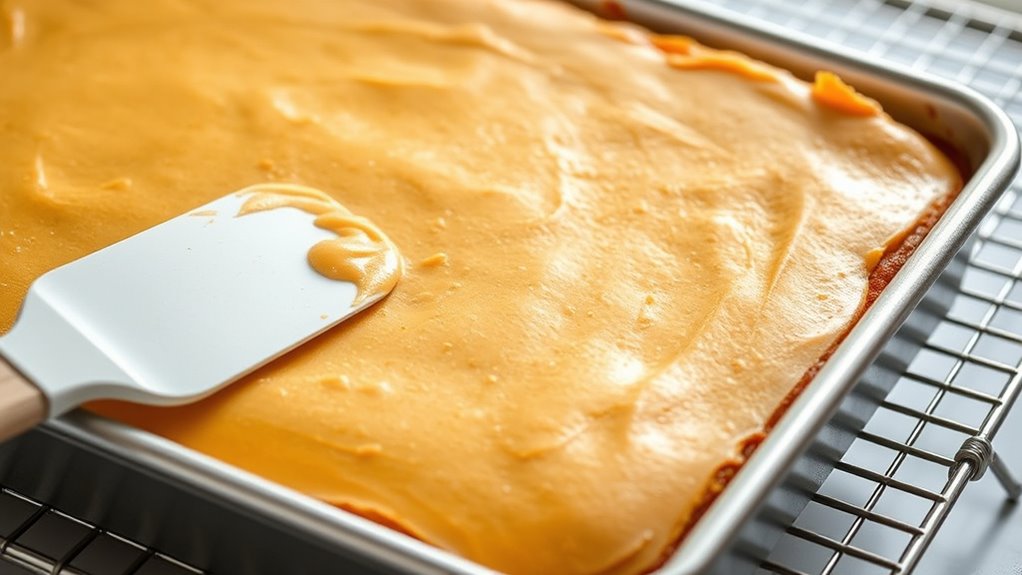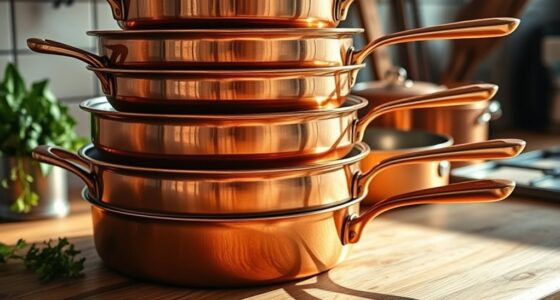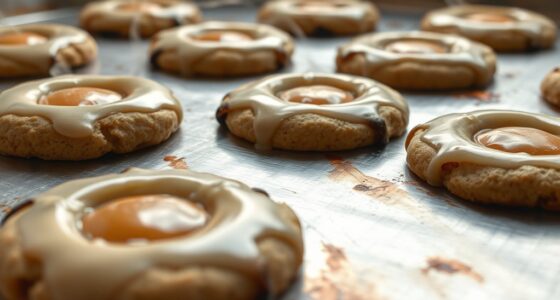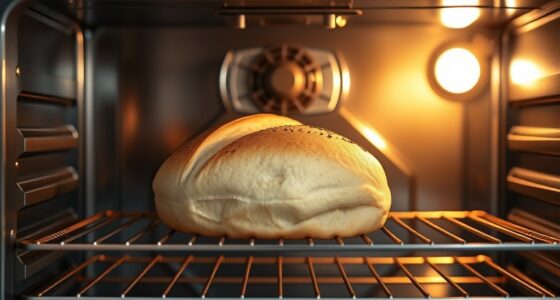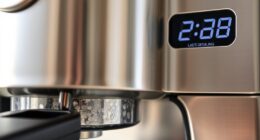To create perfect sheet cakes, choose the right pans—aluminum for even heat, or non-stick for easy release. Before baking, line your pan with parchment or grease and flour it to prevent sticking. Proper prep makes your cake come out smoothly and intact. Chilled, level cakes are easier to decorate. For best results, follow simple tips on storage and handling. Keep going to discover more expert tricks for flawless sheet cakes.
Key Takeaways
- Choose the appropriate size and type of sheet pan, such as aluminum or non-stick, for even baking and easy release.
- Line pans with parchment paper or lightly grease and flour to prevent sticking and facilitate cake removal.
- Properly prepare the pan before baking to ensure the cake releases intact and maintains its shape.
- Chill the cake slightly after baking to make decorating easier and achieve a smooth finish.
- Cover and store the sheet cake properly to maintain freshness and prevent spoilage.
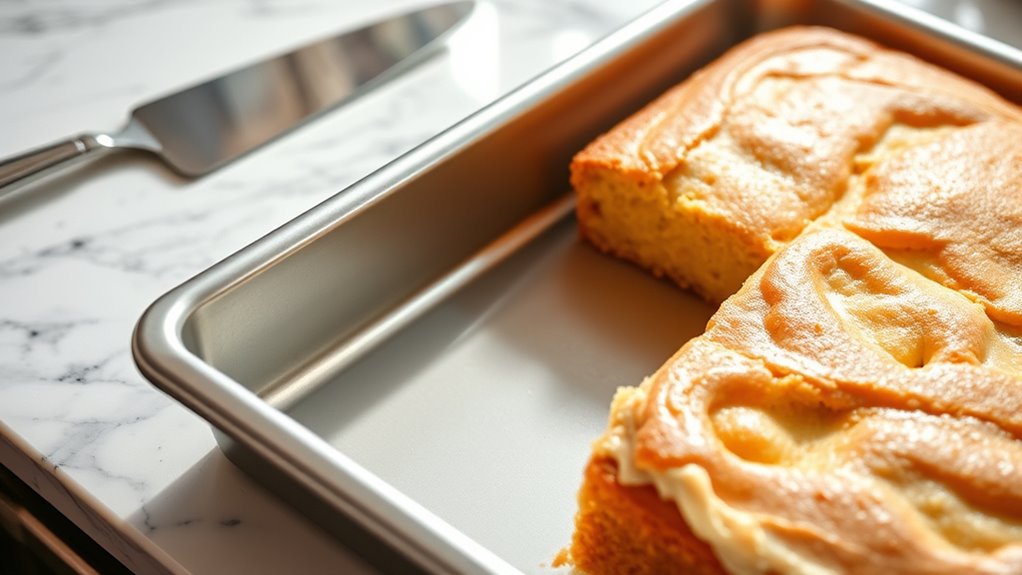
Sheet cakes are a popular choice for birthdays, parties, and gatherings because they’re easy to make, serve, and customize. Whether you’re a beginner or an experienced baker, they offer a straightforward way to create a beautiful dessert without the fuss of intricate layers or tiers. When it comes to making sheet cakes, selecting the right pan size and type is essential. Aluminum pans are popular because they heat evenly, helping your cake bake uniformly. Non-stick pans can make release easier, but you should still take steps to prevent sticking. Proper preparation is key to successful cake release, so lining your pan with parchment paper or lightly greasing and flouring it ensures your cake comes out smoothly. This simple step saves you from frustrating breakage or tearing when removing the cake from the pan.
Once your cake is baked and cooled, the fun begins with cake decorating. Sheet cakes provide a broad, flat surface perfect for creative designs, whether you’re piping borders, spreading frosting, or adding decorative elements like fruits or sprinkles. You don’t have to be a professional to make your cake look festive and inviting; just a steady hand and some basic decorating tools can go a long way. Keep in mind that decorating can be easier if your cake is evenly leveled and chilled slightly before applying frosting. This helps achieve a smooth finish and prevents crumbs from mixing into your icing.
After decorating, it’s important to think about storage tips to keep your cake fresh. If you’re not serving the cake immediately, cover it loosely with plastic wrap or a cake dome to prevent it from drying out or absorbing fridge odors. If your cake has perishable toppings or fillings, store it in the refrigerator. For longer storage, ensure that the cake is well-covered to avoid freezer burn or drying out. When you’re ready to serve, take the cake out of the fridge about 30 minutes beforehand to allow the frosting to soften slightly, which makes slicing cleaner and easier. Proper storage tips help maintain the cake’s flavor and appearance, ensuring it stays as delightful as when it first came out of the oven.
Frequently Asked Questions
What Are the Best Materials for Sheet Cake Pans?
You should choose sheet cake pans made of aluminum or stainless steel for the best durability and even heat distribution. Aluminum pans heat quickly and are lightweight, but stainless steel offers greater durability and resistance to warping. Consider the environmental impact; aluminum is recyclable, making it a more eco-friendly choice. Avoid non-stick coatings that may chip or emit fumes over time. Opt for high-quality materials to ensure your cakes bake evenly and last longer.
How Do I Prevent My Cake From Sticking?
Think of your cake as a delicate dance partner; to prevent sticking, you must give it a smooth, gentle surface. Use cake layer techniques like greasing your pan with butter or shortening, then dust it with flour or parchment paper. For decorative frosting tips, guarantee the surface is even and well-prepared. This way, your cake slides out effortlessly, revealing a flawless, professional finish—ready to dazzle at any celebration.
Can I Use Non-Stick Spray or Butter?
Yes, you can use non-stick spray or butter to prevent your cake from sticking. Both options create a barrier that helps with easy release and guarantee your cake stays intact. For added flavor variety, consider using flavored butter or baking sprays with subtle scents. Once your cake is baked, frosting techniques like smoothing or piping can further enhance its appearance, making it both delicious and visually appealing.
How Do I Clean and Maintain My Cake Pans?
You’ll want to treat your cake pans like precious treasures! After baking, wash them gently with warm water and mild soap—avoid harsh scrubbers that can cause pan rust. Dry thoroughly to prevent rust and store them in a dry, airtight container or hang them up to keep them pristine. Regularly check for rust spots and address them immediately, ensuring your pans stay gleaming and ready for your next baking masterpiece!
What Size Sheet Pans Are Ideal for Different Recipes?
For different recipes, choose sheet pans based on cake portioning and pan size conversions. A standard 9×13-inch pan works well for single-layer cakes, while a half-sheet (13×18 inches) is perfect for larger or layered cakes. Use a quarter-sheet (9×13 inches) for smaller desserts or individual servings. Always consider your recipe’s volume and adjust pan sizes accordingly, ensuring even baking and proper cake height.
Conclusion
Now that you know the secrets to perfect sheet cakes—from choosing the right pans to easy release—you’re ready to create something truly memorable. Think of your cake as a canvas, waiting for your creative touch to turn it into a masterpiece. With a little care and attention, your baking skills will blossom like a well-watered garden. Remember, every cake you make is a step closer to becoming a true baking artist.
